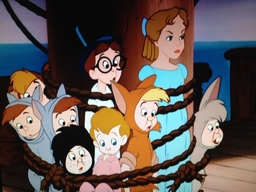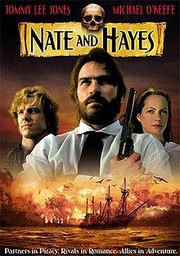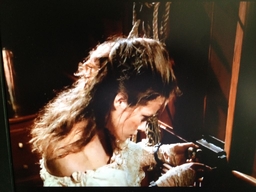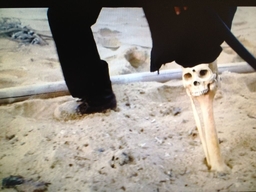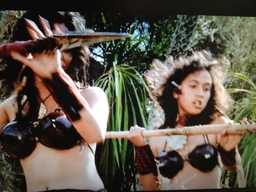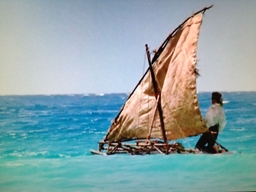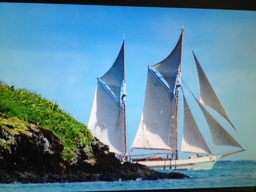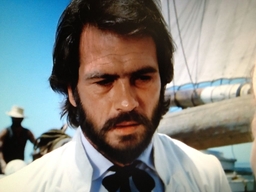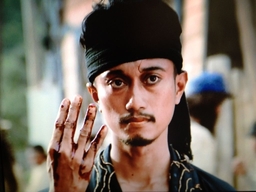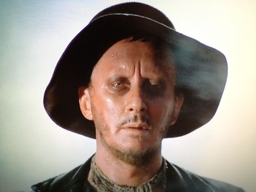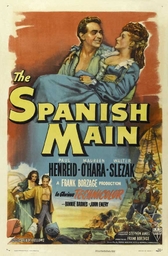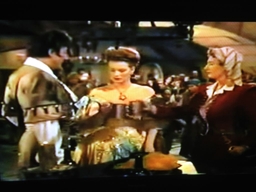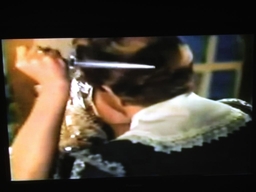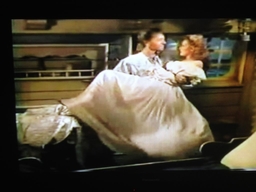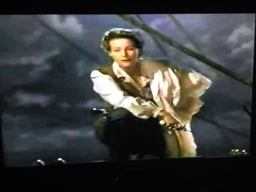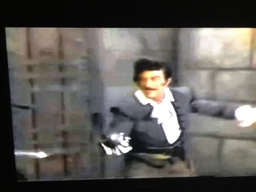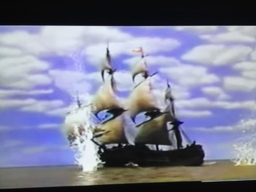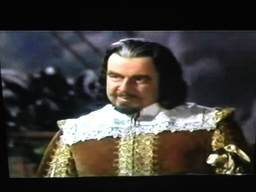-
Posts
652 -
Joined
-
Last visited
Content Type
Profiles
Forums
Events
Gallery
Everything posted by Daniel
-

La Buse the longest serving Golden Age pirate captain?
Daniel replied to Daniel's topic in Captain Twill
In English practice, the pirate's corpse would be dangled from the gallows over the ocean until the tide washed over it three times; this was done also with mutineers or anyone else executed by order of an admiralty court. The "exposed to the sea" order probably reflects something similar in French practice. I have no idea about the two-pound torch. -
John Milton, Paradise Lost. You ever notice that after a certain age, any work of classic literature that you pick up doesn't feel new? You've been hearing quotes from it your whole life; it's like it's familiar to you.
-
John Malkovich is playing Blackbeard. Woohoo! Blackbeard has stolen the world's first longitude chronometer, decades before Harrison actually invented it. OK, so it's obviously not going to be historically accurate, but it still could be fun.
-
NATE AND HAYES (1983) a.k.a. SAVAGE ISLANDS Directed by Ferdinand Fairfax. Featuring: Tommy Lee Jones, Miles O’Keefe, Jenny Seagrove, Max Phipps, Grant Tilly, Peter Rowley, William Johnson, Kate Harcourt, Reg Ruka, Bruce Allpress, Pudji Waseso, Prince Tui Teka. Daniel’s rating: 4 out of 5. Synopsis: Bully Hayes and his crew are running guns to some native rebels. Instead of paying Hayes, the rebels kill his men and chase him into the arms of Spanish bounty hunters. As Hayes awaits his hanging, he reminisces about the events that led him here. When Hayes brought the engaged couple Nate and Sophie to Williamson’s Mission in the South Pacific, Sophie showed clear signs of falling in love with Hayes. After Hayes departs, Nate and Sophie’s wedding is interrupted by Ben Pease and his pirates, who slaughter Nate’s family, enslave the islanders, kidnap Sophie, and leave Nate for dead. To add insult to injury, Pease frames Hayes for the crime. We learn that this is standard operating procedure for Pease, who has a longstanding grudge against Hayes. Hayes never took much notice of this before, but Pease never abducted the woman Hayes loves before. Evaluation: Making movies is all about fakery. Actors pretend to be people they aren’t, pretend to feel things they don’t, and say things that aren’t true, in front of sets that aren’t what they look like, while the special effects make living people look dead and safe people appear threatened. But there is one thing that movie makers can’t fake: a love for their material. If the actors and the director really care about what they’re doing, it will always show, and if they have contempt for it, that can’t be hidden either. Nate and Hayes is one of the first kind: a movie with heart, a movie with joy in its story, in its characters, and above all in its images. Bully Hayes is the sort of character Kenny Rogers would have played in the 1970s, a bearded tough guy who exudes irreverence, always falls for a pretty face, and openly delights in beating stronger, richer, more socially acceptable opponents. He and Ben Pease have both fought their way up from the bottom of the heap, breaking every law in their path, but Hayes has made his fortune by crossing the rich and powerful, while Pease has made it by doing the upper crust’s dirty work. Hayes is the guy we straight males all wish we could be: effortlessly attractive to women, commanding men’s trust and loyalty, lethal in combat, rarely doubting what to do or say. The role requires the actor’s deepest reserves of confidence, and Tommy Lee Jones gives it all he has. Michael O’Keefe’s Nate Williamson is an uptight, headstrong young preacher who is uncomfortable in his own skin. At first, it looks like he’ll be just a punching bag for Hayes, like Slezak’s Alvarado from The Spanish Main, or worse, Beau Bridges’s Major Folly from Swashbuckler. Thankfully, that doesn’t happen. Nate sheds his incompetence as the movie goes on and grows into a hero, saving Hayes’s life and earning his respect in the process. When the inevitable drunken bonding scene comes, it works because the foundation has been properly laid. And instead of going at each other’s throats over their mutual love Sophie, Nate and Hayes actually behave like civilized human beings, promise to leave the decision to Sophie, and refuse to let it get in the way of their friendship. And they both keep their word. When was the last time you saw a love triangle resolved like that? Our leading lady, Jenny Seagrove’s Sophie, is a delight: independent minded, strong , brave, romantic, and beautiful. At the beginning, she clearly thinks she is too much woman for her fiancé, Nate, and Nate begins to suspect the same. Her main problem is that the story doesn’t have enough room for her; this is essentially a buddy movie between Nate and Hayes, and so poor Sophie spends much of the movie shunted into the damsel-in-distress role, complete with the obligatory rescue-me-from-being-a-virgin-sacrifice scene. She deserved better. The usual trouble with a strong hero like Hayes is that he kills suspense by overmatching the villains, but there's no danger of that with Max Phipps around. His Ben Pease is everything a good pirate villain should be: greedy, ruthless, cunning, and vengeful. And boy, has he got a lot to be vengeful about - Hayes once gave him a .44-caliber vasectomy when they fought over a woman. Even better, all Pease's confrontations with Hayes are battles of wits; the two antagonists never once cross blades or trade shots on screen. And Pease is supported by an ensemble of memorable minor baddies. Grant Tilly’s Count von Rittenberg, while harmless and even sympathetic enough in himself, is both powerful and dangerous because of the strength of the Second Reich behind him. Maori rock singer Prince Tua Teke literally chews the scenery as he enjoys his rather hackneyed role as King Oatopi of Ponape. The queen of the native rebels is a menacing, regal presence; Hayes is horrified when she accidentally shoots two of her own warriors with the guns he is selling, but she just laughs and says it proves the guns work well. Nate and Hayes is one of the most violent pirate movies ever made, doing the same thing for the genre of The Black Swan and Treasure Island that Sam Peckinpah’s The Wild Bunch did for the Western. Hayes’s entire crew gets killed off in the first ten minutes, being resurrected only by flashback; pirates massacre peaceful missionaries, chain up their innocent native hosts, and carry them off into slavery; Hayes himself graphically kills lots of attacking native rebels, including several women. Gore, screams, and death rattles visit the screen often. This is only proper for a pirate story, since the whole history of piracy is written in blood, but it was in bad taste to try to make light of the violence with Hayes’s forced one-liners, Nate waving goodbye to a drowning enemy, and the like. The movie’s worst flaw is unnecessary strains on credibility. For example, while Hayes asks a barkeep where Pease is, one of Pease’s crew sneaks up behind Hayes, but he shoots the barkeep instead of Hayes. Hayes invents a clever trap, but then sets it in such a way that it only works through dumb luck. An explosion destroys an entire ship, but the person standing at ground zero of the blast is barely harmed. King Oatopi negotiates with a German envoy and demands shrunken heads and a virgin sacrifice, all of which he could easily obtain himself, instead of guns, ships, modern medicines, schools, or other things that only the German envoy can provide. It must also be admitted that Nate and Hayes is a bit predictable, especially at the end (hmm, I wonder who might show up to help Hayes out of his predicament?). Also, the film’s depiction of the various South Pacific native peoples will strike some people as racist. In the movie’s defense, I would say that many of the natives are perfectly decent people, particularly the ones at Williamson’s Mission, while those that are villainous are no worse than the white pirates and colonialists. Even the inhabitants of Ponape, who are shown in the worst light, are clearly not primitives, but highly intelligent engineers who understand leverage and counterweights. But while I don’t think Nate and Hayes is racist in the sense of depicting South Pacific islanders as mentally or morally inferior, there’s no denying that the film is careless and indifferent to the reality of South Pacific societies and customs. It’s ridiculous to show the Ponapeans continuing to wear their ceremonial masks once a battle breaks out. The costumes given to the native rebels at the beginning are beyond ridiculous. And we have yet another of those native tribes where every one of the women is between ages 18 and 25 and gorgeous. Some viewers will find this unforgiveable; I didn’t. But the best part of the film is the sheer beauty and majesty of the cinematography and the scenery. Every good pirate movie understands that the sea, the ships and the costumes are characters in themselves, just as Stetson hats, horses, and Monument Valley are characters in every good Western movie. This is where the director’s true feelings about his material show up most; no one who doesn’t feel the beauty of the white sails, the blue sea, and the gently curving palm trees can possibly translate that beauty onto the silver screen. If you think that Ferdinand Fairfax couldn’t have gone wrong shooting on location in Fiji and New Zealand, just look at the hideous footage of Roman Polanski’s Pirates, most of which was shot in dazzling Mediterranean locations. In Nate and Hayes, every hue is vivid, every line crisp. The missionary Williamsons aren’t leading their flock to paradise; they’re in paradise already. Hayes’s men are literally a motley crew, no two alike, from Blake with his beautiful burr and faded U.S. Cavalry uniform to Pegleg with his magnificent skull-and-shinbone prosthesis, to Fong’s mesmerizing eyes and dashing headband. And Hayes’s white costume with red sash and pistol is so beautiful that you can’t blame Sophie for falling in love with him. Piratical tropes and comments: Nate and Hayes lacks most of the standard piratical tropes, mainly because it takes place much later than most pirate movies. Hayes is selling a box full of Winchester 1873 rifles to the rebels in the beginning, and lest we dismiss that as an anachronism, Rittenberg says he is the representative of “Kaiser Wilhelm,” which places the action no earlier than 1871. This means that the opening scene is probably in the Philippines, the only big overseas colony that Spain had left by the 1870s, and the site of many rebellions against Spanish rule. It also suggests that the movie is set before 1898, when the U.S. captured the Philippines in the Spanish-American War. Indeed, it’s not immediately clear that Nate and Hayes is a pirate movie at all. Sure, Hayes bombastically says that he’s a pirate, and the Williamsons say he is, too. But Hayes never actually commits any piracy during the movie, and he says that he never pillaged anything. And the Williamsons are probably mistaking Pease's crimes for Hayes's. If Bully Hayes were tried for piracy, he would probably be acquitted. The only real pirates in this movie are Ben Pease and his men, stealing people and selling them into slavery. The slave trade by this time had specifically been defined as piracy, and that alone would be enough to send Pease to the gallows. No wonder that he says his slaves are “contract laborers.” So, the weapons are different from most pirate movies. The swords are mostly cavalry sabers, with Fong wielding what looks like a hiltless Malay or Javan longsword. (Whatever you may have been told, Fong is not a samurai; there is no such sound as “ng” in Japanese, and that sword is nothing like a katana). Hayes and Pease both use .44 Remington revolvers, while their men rely on caplock muzzle-loading pistols; long arms of any kind are mysteriously absent. The native rebels at the beginning fight with triple-barbed spears, much like Filipino war spears. The Ponopeans use gigantic, impractical--looking spiked war clubs, which I suspect are purely imaginary. Also unique are the ships. The Rona is a gaff-rigged schooner, while Pease’s Leonora is a brig. On both vessels, there are signs that the age of sail is ending: anchors are held by chains instead of manilla cables, the hulls are sleek and low, and neither carries any cannon, not even a swivel gun. The director deliberately contrasts the white, swanlike grace of these two vessels to the smoke-belching ugliness of a German steam-powered gunboat. There are no Jolly Rogers in this picture. Hayes expressly – and quite falsely – says that the skull and crossbones flag is fictional. Nor are there any pirate articles; Hayes rules his crew absolutely, though not heavy-handedly. The only eyepatch that appears is on one of the German sailors. And while one of Hayes's men does have a magnificent peg leg, Hayes and his men aren't really pirates at all. In all, Nate and Hayes shows us just how little of the pirate trappings you need to convey the pirate ethos. No headkerchiefs, no cannons, no bucket-top boots, no flintlocks; just picaresque adventures from one danger to another with dashing heroes in sashes are all you need to give us that Jack Sparrow frisson. Are you ready to match beards with Bully Hayes? Sophie's many talents include lock-picking. Even Jack Sparrow's boat was seaworthier than Nate's. Ben Pease. More brains than, well, you know. The Leonora sweeps out from behind the headland. How many did you get, Fong? Not all women are happy to see Hayes. Best. Peg leg. Ever.
- 34 replies
-
- movies
- pirate art
-
(and 3 more)
Tagged with:
-
-
From the album: Nate and Hayes
-
From the album: Nate and Hayes
-
Thank you for the encouragement! I'm going to try to post reviews a little bit more regularly now that I've taken the bar.
- 34 replies
-
- movies
- pirate art
-
(and 3 more)
Tagged with:
-
THE SPANISH MAIN (1945) Directed by Frank Gorzage. Featuring: Paul Henreid, Maureen O’Hara, Walter Slezak, Binnie Barnes, John Emery, Barton MacLane, J.M. Kerrigan, Fritz Leiber, Nancy Gates. Daniel’s rating: 2½ out of 5. Synopsis: When a shipful of Dutch immigrants is shipwrecked off Cartagena, the malicious Viceroy Alvarado orders the survivors enslaved. Laurent van Horn, the Dutch immigrants’ captain, escapes and turns to piracy. When van Horn captures Alvarado’s intended bride, the aristocratic Francesca de Guzmán, he decides to marry her and thus goad Alvarado into sending his valuable ships to recover her. Francesca refuses at first, but then strikes a bargain with van Horn: she’ll marry him if he’ll let her consort ship go free. It is so agreed, and the pirate marries the countess. But many of van Horn’s crew are not pleased with their captain’s decision . . . Evaluation: The Spanish Main is a confusing movie. I don’t know whether to be grateful that it’s as good as it is, despite its glaring flaws, or frustrated at all the potential that it wasted. When both the hero and the villain are duds, you know your movie’s in trouble. Van Horn is played by Paul Henreid, best known today for doing Casablanca, where he played Ilsa’s husband Victor Laszlo. But while Henreid’s mild-mannered persona was perfect for Laszlo, he has none of the panache you need to play van Horn. His thick German accent must have sounded right in auditions for a Dutch pirate, but it garbles a lot of his dialogue. And he shows so little lust or passion for his gorgeous leading lady that he might as well have been gay. Meanwhile, the Hitchcockian maxim that a movie can be no better than its villain hits The Spanish Main hard. Don Alvarado is played by the great Walter Slezak, who gives it his best shot, but this part is too clownish to save. All Slezak can do is yuk up his character’s funny parts, most of which are at the beginning. In the opening scene, when van Horn begs Alvarado’s help for the immigrants whose ship has broken up on Cartagena’s rocks, Alvarado answers: “How inconsiderate of my rocks. I’ll have them reprimanded.” Ha ha, but it’s all downhill from there. Alvarado oozes tons of malice, but not an ounce of danger. The only real challenge to van Horn comes from an unexpected quarter that I won’t spoil for you. The bad news doesn’t end there. The dialogue is fluffy and lusterless, and many of the supporting actors, supposedly Spaniards, drawl as if they’ve just stepped off the set of a John Ford cowboy movie. But a number of strong points save The Spanish Main from total failure, with the actresses leading the rescue. Maureen O’Hara, already a pirate movie veteran from Jamaica Inn and The Black Swan, plays Francesca de Guzmán with effortless grace, guzzling her close-ups and bringing verve to what easily could have been a plastic, insipid part. Meanwhile, Binnie Barnes’s Anne Bonney is a fiery dynamo, stealing every scene she gets as the third leg of the love triangle with Francesca and Van Horn. Frank Gorzage’s direction also diverts The Spanish Main from what seems like certain disaster. After a weak opening, the remaining hour and a half move at lightning speed, cramming a very complex plot into just 100 minutes, and rushing the numerous story holes past the viewer so fast that it’s hard to see them. What Gorzage could not do, though, was decide whether he wanted The Spanish Main to be an action film or a comedy. The comic parts he did well; the perfunctory and uninspired action scenes weigh down the laughs. Most of the cast of The Spanish Main were, or would become, pirate movie veterans. O’Hara was the most freebooting of all; she had already featured in Jamaica Inn and The Black Swan, and would go on to star alongside Errol Flynn in Against All Flags. Henreid, in what I can only call a lapse of judgment by the studios, would star in two more pirate movies: 1950’s Last of the Buccaneers, and 1955’s Pirates of Tripoli. Slezak had played a villain in the previous year’s The Princess and the Pirate, and would go on to play Squire Trelawney in Orson Welles’s Treasure Island. And at the ripe old age of 46, Binnie Barnes would net the leading lady role in The Masked Pirate (aka The Pirates of Capri). In all, The Spanish Main is a film that you’ll see either as half full or half empty. O’Hara, Barnes, and the rollicking action are either good enough that you’ll see them as saving the movie, or good enough to leave you wishing the rest of the movie had been worthy of them. Piratical tropes and comments: The Spanish Main’s plot shows a surprising amount of historical research for a 1940s swashbuckler. Spain’s policy of declaring all foreign vessels in the Caribbean interlopers provides Don Alvarado with his excuse for enslaving van Horn and his passengers. Moreover, pirate articles play a larger role in this movie than in any other I know of besides Treasure Island. They are correctly called “articles,” rather than “the rules” as in Stevenson’s story, and it is made clear that Captain van Horn cannot break them at will. We even get to see a pirate duel conducted under these articles, very loosely following Bartholomew Roberts’s eighth article. The Spanish Main pioneers two plot points that Pirates of the Caribbean would later copy: the prisoner finagling the cell keys out of the guard, and the tongueless pirate. The former, though, is less subtle than in POTC; van Horn simply reaches through the bars and throttles his guard. The guard is conveniently holding the keys in his hand, even though he has no reason to be doing this because he is not letting any of the prisoners out. This greatly simplifies the job of grabbing the keys once the guard passes out. There is also a POTCesque revelry-on-Tortuga on scene, where we first meet Anne Bonney and discover what might have happened to her after Rackham’s hanging. On the costuming front, The Spanish Main is as inaccurate and anachronistic as most of the ‘40s swashbucklers. Although the reference to the “viceroyalty of New Granada,” not to mention Anne Bonney, would suggest a setting in the 1720s, the costume flavor is mostly late 17th century, with broad-brimmed plume hats and the usual Monmouth caps that bend backward instead of forward, and few if any tricorns to be seen. Standard-issue justaucorps appear occasionally, but mostly we see puffy-sleeve shirts, which are probably the most accurate part. Swords are the usual whippy rapiers, with no cutlasses to be seen. The duel is conducted with gigantic flintlock horse pistols; Francesca has trouble cocking hers. Nobody wears any wigs. The cat-o’-nine-tails, a regular actor in Nelsonian movies but not often seen in pirate films, puts in an appearance here to flog Captain van Horn. None of the strokes is shown on screen, showing yet again that Gorzage wasn’t sure whether this movie was comedy or action. The ships here are some very nice little models that only rarely reveal their tiny size. Their sails are color-coded for our convenience in telling pirate ships from Spanish ships, and are very 19th-century in their size and shape. But they are accurately shown with lateen mizzens. And, like Frenchman’s Creek, this movie correctly shows the ships being steered with whipstaves. Oddly, the Jolly Roger puts in no appearance at all. Van Horn’s ship Barracuda is flying some kind of flag, but the print I saw was too fuzzy to make out anything about it. In sum, there’s nothing here for the perfectionist re-enactor, but there is plenty of piratey goodness for everybody else. Why, Captain! Anne Bonney will drink Francesca's health. And then try to kill her. The Barracuda evading fire from the Santa Madre. Binnie Barnes's Anne Bonney cuts a more dashing figure than Henreid's van Horn. The course of true love never did run smooth. John Emery shows his moves as Captain Billar. Walter Slezak's Don Alvarado. Fear my incompetence!
- 34 replies
-
- movies
- pirate art
-
(and 3 more)
Tagged with:
-
From the album: The Spanish Main



